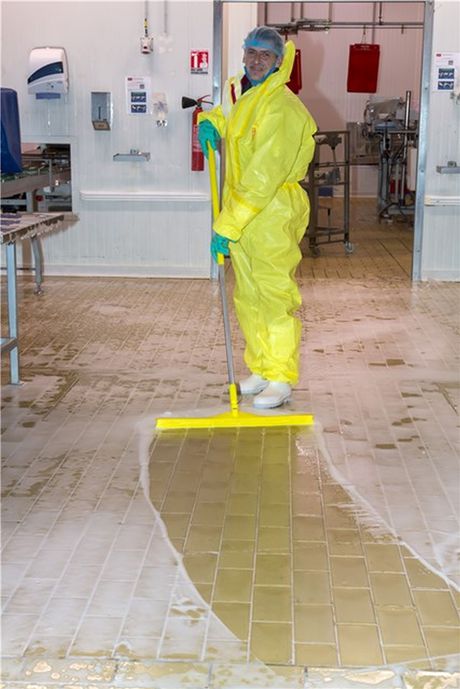Why hygienic design matters when choosing cleaning tools

When it comes to the equipment used to clean the food production environment and production equipment, very few cleaning tools are developed with good hygienic design in mind.
Hygienically designed production equipment is quicker and easier to clean and minimises the risk of product contamination by microbes, allergens, foreign bodies etc. This, in turn, maximises food safety and quality, reduces the risk of expensive product rejection or recall, and minimises food waste.
However, the cleaning equipment itself has been shown to be a major source of contamination. One recent study showed that 47% of the cleaning equipment investigated was contaminated with a harmful bacterium (Listeria monocytogenes). It was not clear whether this was due to poor cleaning of the cleaning equipment or to their poor hygienic design (or both).
Another study found that much of the cleaning equipment currently used in the food industry is difficult to clean due to poor hygienic design. The hygienic design of brushware poses a particular challenge. The most commonly used construction method for brushes and brooms currently involves the drilling of holes into a solid plastic block and then stapling tightly packed filaments into the holes. This creates possible dirt traps both within the holes and between the filaments. Other brushware manufacturing techniques such as fused filament and resin set do exist, but all were shown to have hygienic design issues.
The poor hygienic design of brushware in some high-risk dry goods environments, like baby formula manufacture, has resulted in manufacturers using brushes once and then throwing them away, rather than risk the possibility of cross-contamination.
.jpg)
The ability to clean the cleaning equipment itself is critical to ensuring food safety and quality, and the application of good hygienic design principles makes this possible. This may be the driver behind the new audit requirement in the British Retail Consortium (BRC) Global Standard for Food Safety v7(5), that “cleaning equipment shall be: hygienically designed and fit for purpose” (section 4.11.6).
The European Hygienic Engineering Design Group (www.ehedg.org) has defined principles of hygienic design. To meet their recommendations, hygienically designed cleaning tools should meet the following criteria:
- Free of crevices and contamination traps — use of smooth joins and the absence of small holes, recesses and sharp internal angles.
- A smooth surface finish (Ra less than 0.8 μm).
- Easy to clean (and dry). The equipment must be quick and easy to dismantle and reassemble or be of one-piece construction and have easy access to all areas for cleaning and disinfection.
- Made of food-safe materials. It must be non-toxic (in compliance with EU food contact material legislation).
- Well constructed and durable.
- Non-absorbent.
- Appropriately temperature and chemical resistant. It must be able to safely withstand dishwashing and autoclaving and cleaning and disinfection chemicals.
.jpg)
Deb Smith, a committee member of the UK:IE EHEDG Regional Section and Global Hygiene Specialist with Vikan, explained, “There are many reasons why the application of hygienic design to cleaning equipment is so important. The ability to quickly and easily decontaminate a cleaning tool not only saves time and effort but also improves food safety, quality and shelf life. By minimising the risk of cross-contamination, the risk of product rejection ... consequently, product waste is reduced. The risk of product recall or prosecution is also reduced, thus protecting/improving company reputation and income.”

Vikan, represented in Australia by WR&D Wells and in NZ by Wells Hygiene, is pioneering the development and use of hygienically designed cleaning tools through its Ultra Hygiene range. Using the hygienic design principle defined by EHEDG, Vikan has developed the Ultra Hygiene range for use in areas where hygiene is critical for the maintenance of food quality and safety. The range includes handles, squeegees and brushware. All feature a fully moulded construction, minimal presence of crevices and contamination traps, smooth surface finishes, easy access to all areas for cleaning and disinfection, and durable construction. Additionally, all are made of non-absorbent EU and FDA food-safe materials, which are appropriately temperature and chemical resistant.
Next time you are purchasing cleaning equipment, give a little thought to the benefits hygienic design can offer.
What's new on the shelf
From classic reinspired ice cream to West African flavours in a jar and whiskey aged in a gaol,...
What's new: six on the shelf
From classic chocolatey flavours reinspired to Korean delicacies, have a look at what's new...
What's new on the shelf?
From Aussie/American fusion-inspired hot sauce to a canned protein drink for gamers, have a look...













